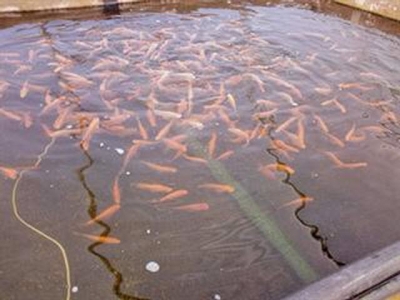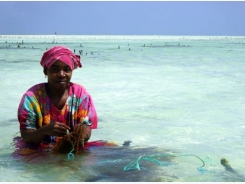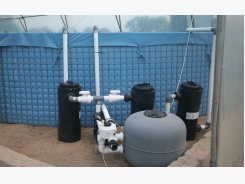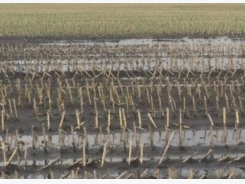Salt water aquaculture

Salinity – at the coast or inland – is rarely a barrier to successful tilapia farming.
Tilapia can be grown in brackish water re-circulating systems.Photo: Nicolas James
Many coastal parts of Southern Africa have access to large volumes of either brackish or full-strength sea water. This water cannot be used for traditional agriculture, but is highly suitable for tilapia farming. There are also inland regions where the groundwater is too salty for irrigation, yet is found in abundance close to the surface. Again, this otherwise useless resource could be used for aquaculture.
Most tilapia species are tolerant of varying degrees of salt (sodium chloride) in the water, an indication of the marine origin of the family. Our indigenous Mozambique tilapia (Oreochromis mossambicus) is the most tolerant of the larger species. It survives and even reproduces in water with a higher salinity than sea water (that is, 35 parts per thousand). This probably explains the natural presence of Mozambique tilapia as far south as the Boesmans River near Port Elizabeth.
During times of strong river flow – and fresh-water input into the sea – the species has migrated from estuary to estuary along the coast. Cold tolerance also appears to be enhanced in saline water. In brackish water, Mozambique tilapia can survive temperatures as low as 9°C, whereas some freshwater populations succumb at about 13°C.
Simple, effective Working model
On a recent visit to northern Mocambique, I saw how people living along the coast were able to farm tilapia successfully in brackish or sea water – in this case, shallow ponds in mud flats adjacent to mangrove swamps. The ponds, each about
50m x 50m, were dug by hand without disturbing the mangroves. A nearby tidal channel supplies water, while a diesel pump fills the ponds with fresh, clean water at high tide. As the system is not on an actual estuary, there is no threat of sudden water-quality changes after heavy rains.
The ponds are fertilised with animal manure to produce algae and macroscopic zooplankton as food for the all-male O. mossambicus. Annual production ranges from 3t to 5t per hectare of ponds. Because the bases of such tidal ponds extend below sea level, groundwater seeps into them and they never run dry. This could be a problem, as the water remaining at low tide has to be pumped out to eliminate any remaining fish before re-stocking takes place. In this instance, however, the ponds are relatively small, with a shallow and deep end, making removal of fish easier.
Inland sources
As mentioned, inland sources of brackish water can also be successfully utilised, even if limited in volume, as is typical of boreholes. A borehole producing 10 000l/hour of brackish water at salinities ranging from 5ppt to 18ppt salt is a valuable resource if reticulated into a closed, tunnel-based recirculating system. Iron is often found in groundwater. The water should therefore be tested to ascertain if levels of iron are low enough for aquaculture.
Farmers close to the sea also have the option of using pumped-ashore water into ponds. In the next article, we’ll discuss the acclimation of the fish to brackish or full-strength sea water, as well as the ‘hapa’ system of nets used as nurseries in this type of aquaculture.
Nicholas James is an ichthyologist and hatchery owner.
Related news
Tools

Phối trộn thức ăn chăn nuôi

Pha dung dịch thủy canh

Định mức cho tôm ăn

Phối trộn phân bón NPK

Xác định tỷ lệ tôm sống

Chuyển đổi đơn vị phân bón

Xác định công suất sục khí

Chuyển đổi đơn vị tôm

Tính diện tích nhà kính

Tính thể tích ao




 US: Novel recycling system turns chicken manure into…
US: Novel recycling system turns chicken manure into…  Timing key in keeping organic matter in wet…
Timing key in keeping organic matter in wet…